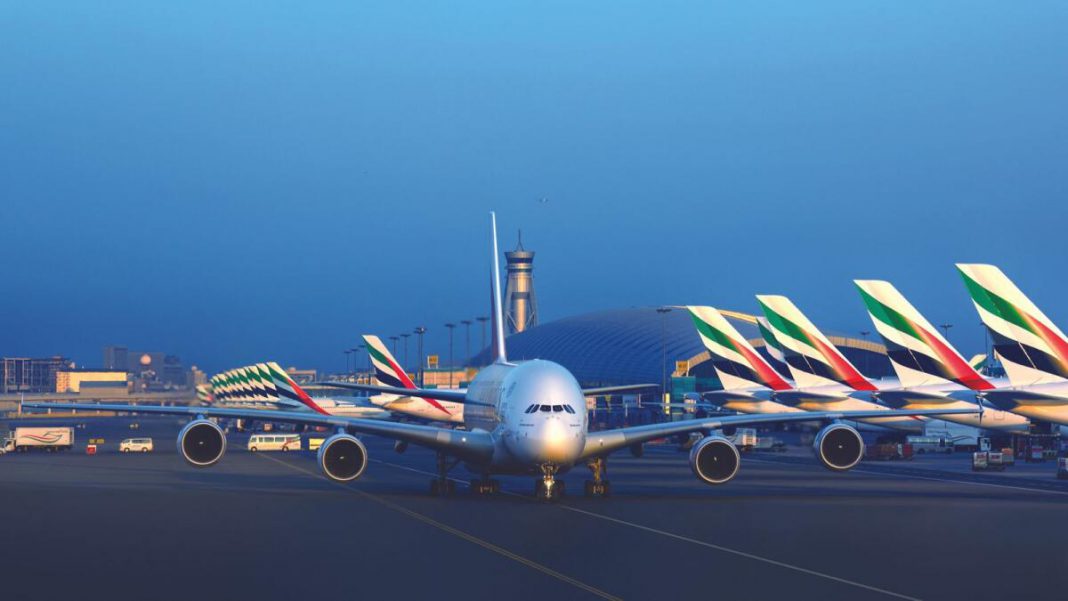Dubai is well-positioned to take advantage of the solid growth in global air travel and the emirate’s aviation sector is expected to continue to fuel its economic expansion over the coming years, a report said.
Dubai’s aviation growth is not only through its geographical location at the meeting point of three continents, but also the government’s determination to invest in the sector, highlights the Emirates NBD Research report written by Daniel Richards, Senior Economist.
The aviation sector has become an increasingly important component of Dubai’s economy over recent decades, bolstered by the development of the emirate’s airports, and by the rapid growth of the national carriers, the report says.
Indeed, in recent quarters aviation has been the key driver of GDP growth in Dubai. With global air travel set to maintain a solid pace of growth over the decades to come.
“With the expected ongoing growth in global air travel, and heavy investment planned into Dubai’s airlines and airports, we anticipate that the sector will continue to be a major contributor to the emirate’s economic growth over the coming years. This will be supported by growth in the domestic population: there are plans to grow the population of Dubai to 5.8 million by 2040, from around 3.6 million presently. Given that this will largely entail people moving here from abroad, this will in and of itself generate growth in aviation numbers as the new inhabitants travel home or on holidays.
“The ongoing growth in Dubai’s tourism sector will also underpin aviation: there were 13.9 million overnight visitors to Dubai over January to October 2023, exceeding the pre-pandemic record of 13.5 million set in 2019. The aim is to hit 40 million visitors by 2040, with the vast majority of these visitors set to come by air,” says the report.
Global air travel continues to grow
Global air travel has averaged annual passenger growth of 5.4% y/y over the 46 years from 1974 to 2019 according to World Bank data citing the International Civil Aviation Organization, Civil Aviation Statistics of the World, and ICAO staff estimates. This has far outpaced global population growth which averaged 1.0% over the same period, as growth in real disposable incomes around the world, combined with an ongoing fall in the real cost of air travel (down 1.7% per year on average since 1970 according to IATA) has led to a steadily growing aviation sector, says the report.
The global Covid-19 pandemic upended markets in 2020, leading to a 60.2% y/y decline in global passenger numbers, but the industry has been recovering rapidly in the subsequent years. As of October 2023, air passenger traffic as measured by revenue passenger-kilometres (RPKs) was just 1.8% off 2019 levels, while seat capacity was at 97.0% of pre-pandemic, according to IATA data.
“Once the final reopening gains have been realised, global passenger growth is likely to continue at a slower pace in the coming years and decades. This is thanks in part to a level of market saturation in some localities, rising environmental concerns around the carbon footprint of air travel, and taxes related to that that could slow the decline in the real cost of travel in some countries.
“However, there remain significantly large growth markets in the developing world that will generate whole new customer bases eager for leisure travel as they move into the middle-income bracket, and aggregate global demand will continue to rise as more people around the world see their disposable incomes expand. IATA projects annual global growth at 3.4% annually over the period to 2040, which would double current traveler levels. In the near term, the return of Chinese passengers to international travel in a more meaningful manner will support growth,” the report points out.
Dubai’s airlines
Dubai’s Emirates airline connects 134 passenger destinations in 76 countries around the world with a fleet of 249 passenger aircraft. The fleet is set to continue growing rapidly as there are presently 305 passenger planes scheduled for future delivery, reflecting the ambitious expansion plans of the airline. At the Dubai Airshow in November, Emirates made a $50 billion order for 95 new Boeing aircraft. The recovery from the pandemic has been swift, and in the first half of 2023, Emirates announced profit of AED9.4bn (up 135% y/y) as it carried 26.1 million passengers over the six-month period, up 31% from H1 2022, the report notes.
In addition to Emirates, FlyDubai also operates out of Dubai. Launched in 2009, the airline now flies to 120 destinations spread over 54 countries with its fleet of 80 Boeing 737s. Over the first nine months of 2023 the airline handled carried over 4mn passengers on y/y growth of 30%, and the airline ordered 30 new Boeing 787 aircraft at the Dubai Airshow.
Dubai’s airports
Both airlines have Dubai International Airport (DXB) as their hub, and here too growth has been rapid, driven not only by the national carriers but also all the other airlines that operate through the facility, including majors such as Singapore Airlines, Ethiopian Airlines, and British Airways. The biggest facility in the world for international traffic, DXB connects over 240 destinations around the world. It is on track to handle 86.8 million visitors this year, just shy of the record 2018 figure, a remarkable feat with international Chinese passenger traffic yet to fully recover. The airport still has spare capacity of around 30 million visitors annually but given Dubai’s plans to continue focusing on the aviation sector to drive GDP growth, the ambition is to grow far beyond this, it highlights.
In the near term, DXB is set to see a $1.6 billion to $2.7 billion expansion over the next seven years that will turn it into a smart airport, with design optimisations to streamline operations. This will help it reach its capacity of around 120 million passengers a year over the next decade or so, but the longer-term focus will be on Dubai’s newer airport, Dubai World Central (DWC, or Al-Maktoum International). DWC can currently handle around 7 million passengers but there is potential to expand this to 130 million passengers over Phase 1 and a massive 250 million travellers and 15 million tonnes of cargo annually once Phase 2 of the development plan is completed over the course of the next several decades. The airport will have five runways and 400 gates spread across 65 sq km.
GDP contribution
The individual contribution of the aviation sector to Dubai’s national accounts is not available, but the component to which it belongs, transport & storage, has been the major driver of Dubai’s economic growth in recent quarters. Transport & storage, which accounts for 14% of real GDP, expanded 10.5% y/y in H1 2023, contributing 42.8% of total growth, far exceeding second-placed trade which generated 12.9% of the expansion. The communiqué from WAM highlighted the role played by the aviation sector, stating that the travel & tourism ‘sub-sector’s performance was positively impacted by the increase in the demand for the services of national carriers…’
Finally, the focus by Emirates and Dubai Airports on linking the world’s biggest and busiest destinations will mean that transit traffic continues to grow. This will likely come at the expense of other traditional hub airports such as London, where the desire or ability to expand capacity through building new runways or terminals is lacking, the report notes.
“Dubai is not alone in looking to secure this growing business – Saudi Arabia is also looking to build up its aviation sector, launching a new airline Riyadh Air and aiming to serve 100 destinations globally by 2030. The expansion of Air India, with the world’s largest ever aircraft order for 470 new planes made this year, could also impinge on Dubai’s growth given the large number of passengers traveling to or from India that pass through DXB. The launch of ultra-long flights might also challenge DXB’s hub model over the coming decades as airlines look for more efficient smaller aircraft that can go directly from the UK to Australia, for instance.
“Nevertheless, the size of the growth market in Sub-Saharan Africa and Asia in particular, alongside Dubai’s first-mover advantage, will likely mean that growth in transit traffic remains robust,” it adds.


